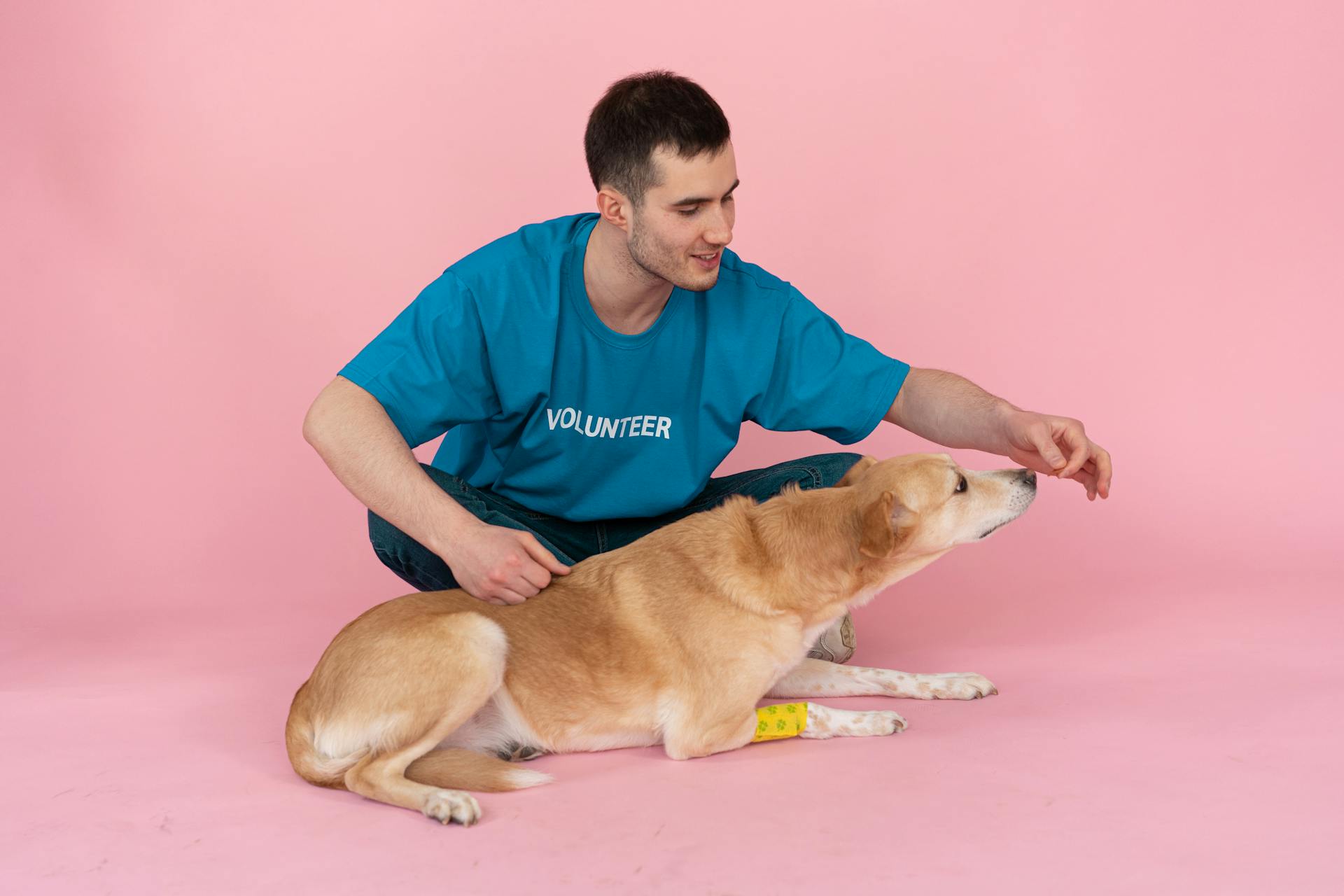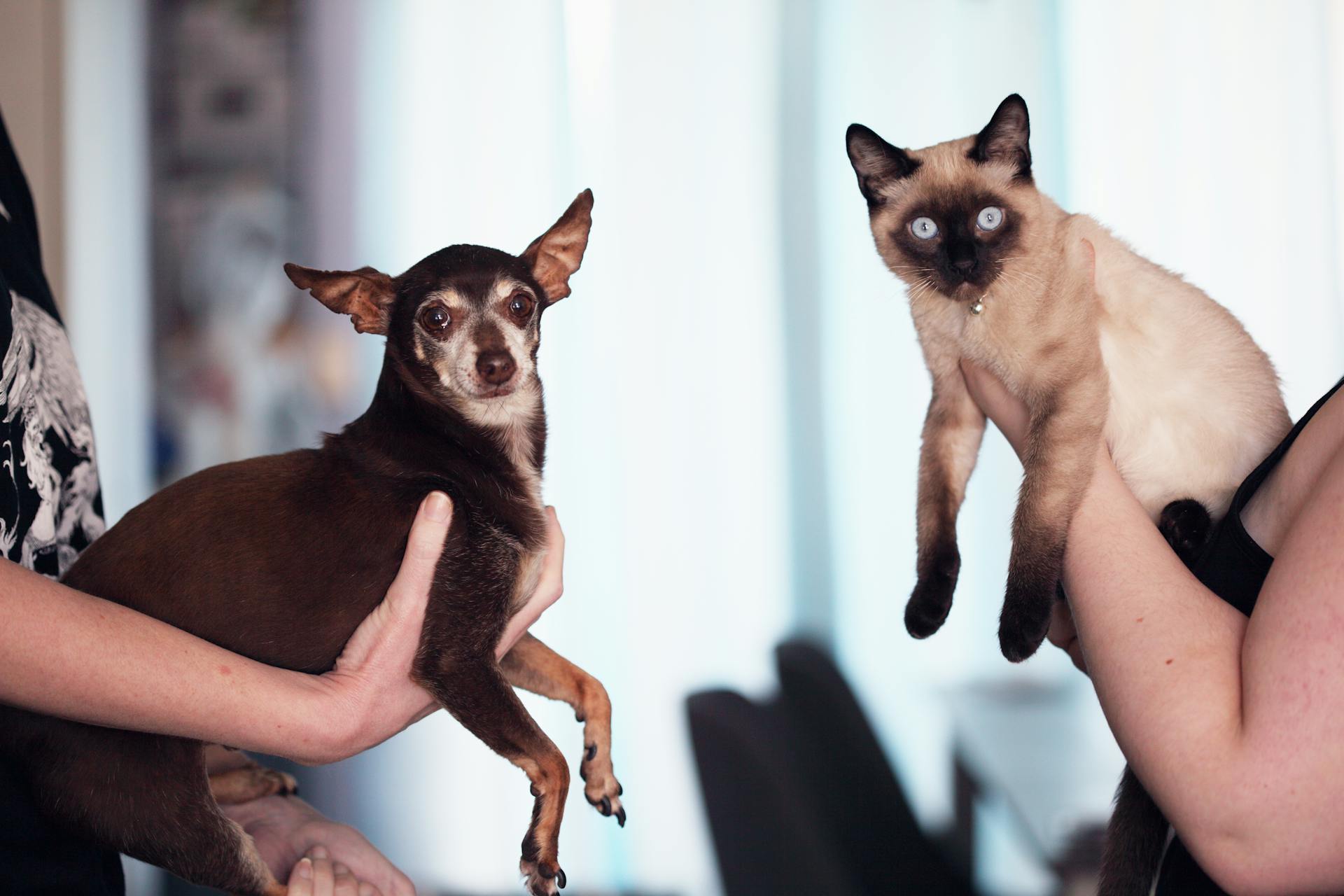
Getting two male dogs to get along can be a challenge, but it's not impossible. According to research, introducing two male dogs to each other at a young age can help them develop a harmonious relationship.
In fact, studies have shown that dogs that are socialized together from an early age are less likely to fight as adults. This is because they learn to communicate and respect each other's boundaries from a young age.
It's also worth noting that some breeds are more prone to aggression than others, but even within breeds, individual personalities can vary greatly. For example, a high-energy breed like a Labrador Retriever may require more exercise and stimulation to prevent boredom and aggression.
By understanding the unique needs and personalities of each dog, you can create a harmonious home for two male dogs to live together in peace.
Readers also liked: Why Is My Female Dog Hump My Male Dog
Creating a Peaceful Living Space
Creating a peaceful living space is crucial for two male dogs to get along. Designate specific zones in your home as peaceful areas where each dog can relax without being disturbed by the other.
These areas should be separated enough to give each dog a sense of their own territory. Consistency is important, so always maintain these consistent, designated peaceful areas in your home.
A predictable schedule is crucial for dogs to coexist calmly. Establish clear routines for walking, eating, and resting times.
Here are some tips to help you create a peaceful living space:
• Designate specific zones for each dog to relax
• Keep these zones separate and consistent
• Establish clear routines for walking, eating, and resting times
By following these tips, you can create a peaceful living space that allows your two male dogs to coexist calmly.
Consider reading: Can Dogs Get Sick from Walking in the Rain?
Managing Conflict
Using body blocks is a great tool for guiding your dogs' behavior when they're at odds. It's a non-verbal form of communication that your dogs are always watching and can respond to immediately.
A well-timed body block can stop a behavior right as it happens, making it a useful technique for managing conflict. This method isn't about pushing or scolding, it's gentle and clear.
Common triggers for aggression include competition for resources like food, toys, or owner attention. To avoid these triggers, it's best to feed, give treats, and play with your dogs separately.
Here are some situations that can trigger aggression:
- Competition for resources (food, toys, treats, owner proximity or attention)
- Situations that induce excitement (greeting people, play sessions, walks, car rides, etc.)
By separating your dogs or intervening before they become too excited, you can help prevent conflicts. In some cases, dogs may need to be completely separated and then gradually reintroduced with desensitization and counter-conditioning training.
Causes of Conflict
Conflict among dogs often arises from resource guarding. This can be a major issue if not addressed.
Redirecting aggressive behavior with firmness and consistency is key. Each dog should understand that politeness earns privileges like toys, affection, and treats.
Competition over territory can also lead to conflicts. This can be due to misunderstandings about social hierarchy.
One-on-one play can help prevent conflicts in dogs who tend to dominate playtime. This can be a great way to give them the attention they crave without overwhelming others.
Crate training may be a good option for dogs who tend to destroy furniture when unsupervised. This can help keep them safe and prevent damage to property.
Here's an interesting read: Can Dogs Only Have 1 Puppy
Recognizing Warning Signs
Mounting behavior is a warning sign that indicates potential conflicts between male dogs. If you notice your dogs engaging in this behavior, it's essential to intervene promptly.
Excessive marking or urination is another sign that may indicate competition over territory. Ensure each dog has their own designated areas and resources to reduce this behavior.
Growling and snapping are clear warning signs that your dogs are becoming aggressive. If you notice these behaviors escalating or becoming frequent, take action to prevent any further escalation.
Intense staring can also be a warning sign that your dogs are preparing for a confrontation. Be vigilant and intervene if you notice this behavior.
By recognizing these warning signs, you can take proactive steps to prevent conflicts between your male dogs.
For more insights, see: Why Does My Male Dog Lick My Female Dogs Ear
Body Blocks for Conflict Resolution
Using body blocks is a non-verbal communication technique that can be a game-changer in managing conflicts between dogs. Your dogs are always watching how you move and are good at reading body language.
Immediate feedback is key with body blocks. A well-timed body block can stop a behavior right as it happens, which is especially helpful for dogs that live in the moment.
This method isn't about pushing or scolding, it's gentle and clear. By using body blocks, you can guide your dogs' behavior without using physical force.
Here are the benefits of using body blocks:
- Non-verbal communication
- Immediate feedback
- No force needed
Training and Boundaries
Establishing clear boundaries is essential when introducing multiple dogs into your household. This helps prevent conflicts over dominance.
Training routines should be consistent and started early on to establish yourself as the pack leader. Separate training sessions for each dog are recommended before gradually integrating them into joint sessions.
Clear boundaries and rules should be set to prevent potential conflicts. This includes setting rules for obedience training and ensuring both males understand their place in the pack.
Training sessions should be conducted separately initially to prevent competition and dominance issues. This allows each dog to focus on their training and form a bond with their handler.
By setting rules early on, you can minimize potential conflicts and create a harmonious household. Consistent training and clear boundaries are key to a successful multi-dog household.
Safety and Professional Help
Safety is a top priority when introducing two male dogs to each other. Traditional muzzles that close the mouth should not be used, but basket muzzles can be considered for all dogs in the household.
Aversive citronella spray, such as Spray Shield, can be used to startle the dogs apart during a fight without harming them. Trailing leashes on head collars, like the Gentle Leader, can also be grabbed to separate the dogs if aggressive behavior occurs.
If fighting is severe, dogs should be completely separated until conditioning and other treatment protocols can be put in place. Re-homing should be considered if the aggression poses a significant safety issue.
Safety
Safety is crucial when dealing with dog aggression, and there are some practical tools that can help prevent injuries. Aversive citronella spray, such as Spray Shield, can be used during dog fights to startle the dogs apart without harming them.
Traditional muzzles that close the mouth should not be used in this situation, as they can cause more harm than good. Basket muzzles, on the other hand, allow dogs to eat, drink, and pant while still preventing biting.
If fighting is severe, dogs should be completely separated until conditioning and other treatment protocols can be put in place. Re-homing should be considered if the aggression poses a significant safety issue, so it's essential to consult with a veterinarian for guidance.
Seek Professional Help

If you're experiencing issues with your male dogs fighting, don't be afraid to seek help from a professional. Male dogs may fight despite your best attempts.
A dog trainer or behaviorist can examine the problem and provide personalized advice. They can help you identify the root cause of the fighting and develop a plan to address it.
In some cases, a professional may recommend managing and improving the relationship between your male dogs. This can involve training, behavior modification, or simply providing separate spaces for each dog.
Worth a look: Age to Breed Male Dogs
Frequently Asked Questions
Do neutered male dogs get along?
Neutered male dogs are more likely to get along with other dogs, with aggression decreasing by over half after altering. This can lead to a more harmonious household and reduced conflict with other pets.
Can two unneutered male dogs live together?
While possible, housing two intact male dogs together requires careful consideration and management to prevent potential conflicts. Success depends on understanding their individual temperaments and taking proactive steps to prevent problems.
Are male dogs aggressive to other male dogs?
Yes, intact male dogs can be aggressive towards other male dogs, even in the absence of females, due to natural instincts and territorial behavior. This aggression can occur between males living together or in unfamiliar situations.
Do male dogs do better with male or female dogs?
Male dogs may get along better with female dogs, as they tend to avoid dominance competitions. However, it ultimately depends on each dog's unique personality and temperament.
Can two dominant dogs live together?
Dominant dogs can coexist if one clearly acknowledges the other's dominance, but introducing two dominant dogs without a clear hierarchy can lead to conflicts
Sources
- https://pawsafe.com/blogs/dog-training/how-to-make-two-dogs-get-along
- https://www.tlcvetelpaso.com/blog/1010-aggression-between-family-dogs
- https://www.petmd.com/dog/conditions/behavioral/c_dg_AggressionInterdog
- https://thelightofdog.com/can-two-intact-male-dogs-live-together/
- https://nurtureyourpet.com/blogs/lifestyle/can-two-male-dogs-live-together
Featured Images: pexels.com


